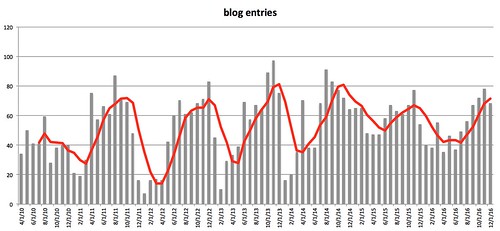I'm reposting from January 1, 2017, almost two years ago, but with the latest stats. As the title indicates, it’s about my blog posting since I started New Savanna. Here’s the new stats:
The length of a bar is proportional to the number of posts I made that month. Black bars indicate January.
A little calibration is in order. You’ll notice that prior to this year there wasn’t a single month with 100 posts; the highest was November 2013 with 97. Now, as of the end of October, we’ve got three months with 100 or more posts; what will November and December bring? But those months really aren’t directly comparable to the whole previous run. Why? Because it’s in those months that I began using Tweets as blog posts. I hadn’t done that before, but if I’d known that was possible, I’d have done it.
Why? Because it’s a low-energy way to make a post. And low energy’s is what’s going on in those slumps. Why the low energy? That’s what the rest of the post is about.
Finally, on December 18 of last year I posted, Reflections on entering my eighth decade and why it portends to be the most productive one of my life. When I posted that I can assure you that I was not anticipating the slump that slammed me in February and kept me down through June. Will that happen again? Who knows? But notice 2015; the slump wasn’t so bad. Who knows?
* * * * *
In October of 2015 I had a post at 3 Quarks Daily entitled, Have the Internets Rotted My Brain and Wrecked My Mind? I included the following figure:
Each column represents on month’s worth of posts, starting with April 2010 and running through September 2015. Here’s what I said about it then:
It’s a very spiky pattern, with the dips happening in the winter months. Ever since I went away to college winter has been a down time for me. Am I afflicted with seasonal affective disorder? I don’t know.Look at the recent end of that chart (to the right). There is a dip, but it’s not nearly so deep as in previous years, and the lowest three months aren’t in the winter, but in the spring and early summer. Wrong season. The pattern seems to be different.
I’ve now updated the graph to the end of last year:
The cyclicity continues, though, if you look closely, the troughs don’t line up particularly well with winter for 2015 and 2016. The 2015 trough is in spring while the 2016 trough is roughly the first half of the year.
What’s going on? Of course, I don’t really know, other than the obvious changes in blogging productivity. I do think my mood follows my productivity, or vice versa, and that’s what’s interesting. David Hays once conjectured that melancholy (aka depression) is the price you pay for large-scale reorganization or the sort implied by creativity. “Reorganization” is a term of art from William Powers’s account of the mind. It is so deeply embedded in that theory that there is, alas, no easy gloss.
Start out by thinking of learning. When you learn, your mind is also reorganizing on a large scale. Now think of mourning as well. When you mourn the loss of someone close you have to reorganize your mind for life without them. You don’t actually learn anything, but you have to figure out how to function in those situations where you would have go to that person. It’s unlearning.
In order to be creative you must first unlearn on a large scale. That is accompanied by melancholy. That, on this view, accounts for those troughs in my intellectual output, which is mostly though not entirely through New Savanna. That creates some “slack” in the system. Once enough unlearning has taken place I can then think new thoughts and my productivity goes up. When the slack has been used up, it’s time for more unlearning.
Do I believe this? How could I? I just made it up. And it’s rather vague, too vague to support strong belief. Still, I’m attracted to the idea that something like this is going on over the long haul.
Addendum, 1.2.17: Are we dealing with reorganization on a scale where we could talk of neural plasticity?
Addendum, 1.2.17: Are we dealing with reorganization on a scale where we could talk of neural plasticity?



Immigrants often report emotional moods little different from those of bereavement.
ReplyDeleteAlteration in the normal rhythms of life. 'Stranger in a strange land.'
The high 'burn out' rate at university has for centuries identified melancholia as the disease of scholars (correlation rather than cause)
Melancholic genius also relates to the connection of ideas, the ordering of the system.
Climates relationship with the human body under the system of the four humors.
North Europe needed a vehicle to explain how could damp environments (melancholic by nature) could produce genius (traditionally the home of genius, the sun kissed island of classical humor and its dry wit).
p.s in terms of visual history and the investigation of second sight, melancholia was a factor investigators went to pains to point out did not exist.
ReplyDeleteSuggests a grading scale and as black melancholia is the lowest form presumable white melancholia was its highest form.
YES!
ReplyDelete"Are we dealing with reorganization on a scale where we could talk of neural plasticity?"
ReplyDeleteBack to waffle mode.
Yes does seem to be the answer.
p.s Mary Floyd Williams, English Ethnicity and Race in Early Modern Drama. Is a good read in regard to the history of the subject.
ReplyDeleteBruce Wexler's brain and culture on immigration and emotion.